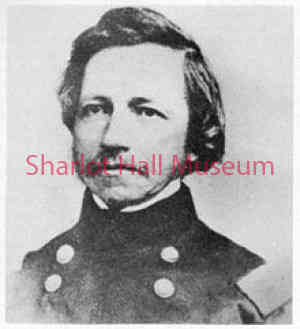By Barbara Patton
In October, 1853, Army officer Lt. Amiel Whipple led a large exploratory party into Albuquerque, New Mexico. Their mission was to explore and survey the 35th parallel in search of a railway route to the Pacific Coast. Starting in Washington D.C. in April, Whipple hired a cadre of surveyors and scientists. From the nation’s capital, they traveled by boat and train to Fort Smith, Arkansas, where Whipple completed his party with teamsters, herders and other necessary personnel. When they left Fort Smith, there were 110 in the party, including a company of fifty soldiers of the Seventh Infantry commanded by Lt. John M. Jones. They also had a herd of 250 mules, 13 wagons and two small carts.
 It took three months to reach Albuquerque where Whipple took a month to resupply his team and find a qualified guide to lead them into the uncharted area ahead. Ultimately, he hired both the experienced French/Canadian Antoine Leroux and a Mexican guide named José Manuel Savedra.
It took three months to reach Albuquerque where Whipple took a month to resupply his team and find a qualified guide to lead them into the uncharted area ahead. Ultimately, he hired both the experienced French/Canadian Antoine Leroux and a Mexican guide named José Manuel Savedra.
There was much trepidation among Whipple’s men about the route ahead. Although there had been other expeditions into the area, all were difficult and the resulting maps were incomplete. One of these expeditions was the Sitgreaves campaign, which battled thirst, starvation and natives. Antoine Leroux, who was with Sitgreaves, was seriously injured in one of the battles.
Leaving Albuquerque on November 9, Whipple’s expedition followed a well-marked route to Zuni on today’s New Mexico/Arizona border. They arrived in late November and camped several miles from the pueblo because of a smallpox epidemic. Being immune to the disease, Whipple was the only one who visited the village to explain to the chiefs what the expedition was trying to accomplish. Eventually, the Zuni leaders offered to send guides to lead the expedition to the Little Colorado River. Beyond that, Hopi guides would have to be arranged.
The Zuni guides led Whipple’s men across Navaho territory. On the way, they encountered only two Navaho who, afraid of smallpox, hurried away. This was a well-founded fear because several of Whipple’s men also contracted the disease.
When they reached the Little Colorado River on December 5, two Zuni guides who had been dispatched to the Hopi pueblos arrived back with word of smallpox at the pueblos. There would be no Hopi guides to lead the expedition onward.
Shortly after, twenty-five bearded, frontier-hardened infantrymen arrived from Fort Defiance. They were a welcome addition to the expedition which had lost men through resignations and desertions. They were now 115 strong.
Two nights later, a nearly disastrous event occurred when a coyote frightened an officer’s horse, causing a stampede of the horses and mules. The next morning, they discovered half the mule herd missing. Without these animals, the expedition couldn’t continue. All day, search parties looked for the mules and returned without them. Finally, after dark, news came that some of the Mexican herders had continued searching despite the threat of attack and found the wayward mules. Whipple was very impressed and highly praised the Mexicans in his journal.
After Whipple found he wouldn’t have any Hopi guides to lead the expedition westward, he decided to take a small exploratory group to the west and leave the main group camped where they were. On the morning of December 13, despite cold and rain, Whipple and thirty men headed west into the desert. After some rough travel, his small group was back on the Little Colorado. Whipple sent word to the main group to move the camp forward to that location.
 Despite chilling temperatures, Whipple’s small group headed towards the San Francisco Peaks. On December 17, they found a spring in the foothills of the mountains near present-day Flagstaff. Leroux recognized the spring as one he had seen on the Sitgreaves expedition.
Despite chilling temperatures, Whipple’s small group headed towards the San Francisco Peaks. On December 17, they found a spring in the foothills of the mountains near present-day Flagstaff. Leroux recognized the spring as one he had seen on the Sitgreaves expedition.
Whipple named the springs after Leroux, and the next day he and his men returned to the main camp where they joined the rest of the party.
Next up, the expedition continues across Arizona.
“Days Past” is a collaborative project of the Sharlot Hall Museum and the Prescott Corral of Westerners International (www.prescottcorral.org). This and other Days Past articles are also available at https://sharlothallmuseum.org/articles/days-past-articles.l. The public is encouraged to submit proposed articles and inquiries to dayspast@sharlothallmuseum.org. Please contact SHM Library & Archives reference desk at 928-445-3122 Ext. 2, or via email at archivesrequest@sharlothallmuseum.org for information or assistance with photo requests.


